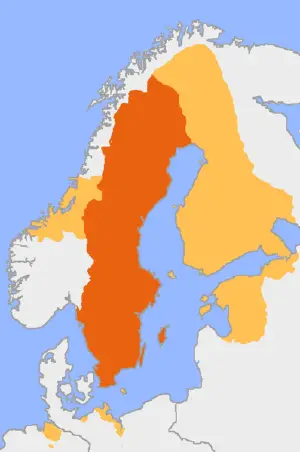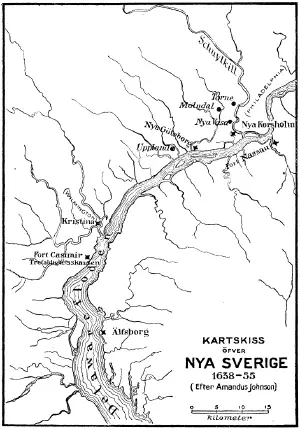Difference between revisions of "Swedish colonial empire" - New World Encyclopedia
| Line 1: | Line 1: | ||
| − | |||
| − | |||
| − | |||
| − | |||
[[Sweden]] possessed overseas colonies from [[1638]] to [[1663]] and from [[1784]] to [[1878]]. | [[Sweden]] possessed overseas colonies from [[1638]] to [[1663]] and from [[1784]] to [[1878]]. | ||
| Line 8: | Line 4: | ||
==Background== | ==Background== | ||
That Sweden possessed a colonial Empire is a less well known fact than that [[Spain]], [[Great Britain]], [[France]] or [[Netherlands|Holland]] had their extensive [[imperialism|imperial]] projects. This is due to the fact that the Swedish colonies were fewer and smaller than were those of other powers. | That Sweden possessed a colonial Empire is a less well known fact than that [[Spain]], [[Great Britain]], [[France]] or [[Netherlands|Holland]] had their extensive [[imperialism|imperial]] projects. This is due to the fact that the Swedish colonies were fewer and smaller than were those of other powers. | ||
| − | As a state that played a significant role in [[Europe]], with a history of sea-faring, Sweden, as did other European nations, wanted trading partners, sources of raw material and outlets for its own products, just as other nations did. At times in her history, Sweden had ruled or was united with [[Norway]] and governed a land-based empire in the [[Baltic]] including [[Finland]]. She invaded [[Poland]], threatened [[Russia]] and | + | As a state that played a significant role in [[Europe]], with a history of sea-faring, Sweden, as did other European nations, wanted trading partners, sources of raw material and outlets for its own products, just as other nations did. At times in her history, Sweden had ruled or was united with [[Norway]] and governed a land-based empire in the [[Baltic]] including [[Finland]]. She invaded [[Poland]], threatened [[Russia]] and Sweden-Norway in fact was ahead of such nations as [[GermBerlin Conference (1884) |
[[Image:Sweden in 1658.PNG|thumb|Sweden's land-based empire in 1658.]] Sweden's population doubles during the hundred years period from the mid seventeenth to the mid eighteenth centuries, when industrialization also began. Population growth and industrialization contributed to Sweden's desire to join the scramble for colonies. | [[Image:Sweden in 1658.PNG|thumb|Sweden's land-based empire in 1658.]] Sweden's population doubles during the hundred years period from the mid seventeenth to the mid eighteenth centuries, when industrialization also began. Population growth and industrialization contributed to Sweden's desire to join the scramble for colonies. | ||
Revision as of 14:34, 16 July 2008
Sweden possessed overseas colonies from 1638 to 1663 and from 1784 to 1878.
Background
That Sweden possessed a colonial Empire is a less well known fact than that Spain, Great Britain, France or Holland had their extensive imperial projects. This is due to the fact that the Swedish colonies were fewer and smaller than were those of other powers. As a state that played a significant role in Europe, with a history of sea-faring, Sweden, as did other European nations, wanted trading partners, sources of raw material and outlets for its own products, just as other nations did. At times in her history, Sweden had ruled or was united with Norway and governed a land-based empire in the Baltic including Finland. She invaded Poland, threatened Russia and Sweden-Norway in fact was ahead of such nations as [[GermBerlin Conference (1884)
Sweden's population doubles during the hundred years period from the mid seventeenth to the mid eighteenth centuries, when industrialization also began. Population growth and industrialization contributed to Sweden's desire to join the scramble for colonies.
The former Swedish colonies in Africa were:
- Swedish Gold Coast (1650-1663; lost to Denmark and the Dutch) Including Cape Coast (1649-1663) consisting following settlements:
- Apollonia, present Benin: 1655-1657.
- Fort Christiansborg/Fort Frederiksborg, which became the capital, present Osu: 1652-1658
- Fort Batenstein, present Butri: 1649-1656.
- Fort Witsen, present Takoradi: 1653-1658.
- Carolusborg: April 1650 - January/February 1658, 10 December 1660- 22 April 1663
The former Swedish colonies in America:
- Guadeloupe (1813-1814;returned to France)
- Saint-Barthélemy (1784-1878; sold to France)
- New Sweden (1638-1655; lost to the Dutch)
In the Americas
New Sweden
By the middle of the 17th century, the Swedish Empire had reached its greatest territorial extent. The Swedes sought to extend their influence by creating an agricultural (tobacco) and fur trading colony to bypass French, British and Dutch merchants. The charter included Swedish, Dutch and German stockholders. Once they landed they established, Fort Christina (now Wilmington, Delaware), named after Queen Christina of Sweden. Many of the settlers were Finnish; since until 1809 Finland was governed as the eastern third of the kingdom of Sweden.
The settlement was actually an invasion of New Netherland since it was Dutch territory. The first governor, Peter Minuit, died after returning from Stockholm by a hurricane while on the island of St. Christopher in the Caribbean. The colony would establish Fort Nya Elfsborg north of present-day Salem, New Jersey in 1643.
In May 1654 the Dutch fort Casimir was conquered by New Sweden. As a reprisal, the Dutch governor Peter Stuyvesant sent an army to the Delaware River, which obtained the surrender of the Swedish forts.
Antillian possessions
As a result of Sweden's support of France's enemies during the Napoleonic Wars, the island of Guadeloupe was ceded to king Charles XIV John personally, not to his Swedish state.
However a year later the island was given to France by the Treaty of Paris. Sweden then forced a settlement with Great Britain because it had been guaranteed the island which was strategically close to its other Caribbean colony. This led to the Guadeloupe Fund which guaranteed Sweden 24 million francs. Because of how the money was used, Sweden was then given an additional 300,000 Riksdaler under the Riksdag of 1815 every year. The last installment was paid in 1983.
In Africa : Swedish Gold Coast
Sweden temporarily controlled several settlements on the Gold Coast (present Ghana) since 22 April 1650, but lost the last when on 20 April 1663 Fort Carlsborg and the capital Fort Chistiansborg were seized by Denmark.
Cape Coast
In 1652, the Swedes took Cape Coast (in modern Ghana) which had previously been under the control of the Dutch and before that the Portuguese. Cape Coast was centered around the Carolusburg Castle which was built in 1653 and named after king Charles X Gustav of Sweden but is now known as the Cape Coast Castle.
The Swedish Atlantic slave trade
During this time the small Swedish slave trade began. However, after the fall of New Sweden to the Dutch, the slave trade ended. It would later be rejuvenated under Gustav III who would founded a Swedish colony on Saint-Barthélemy in 1785 and made the island a center for slave trading. The Swedish West India Company was established on the island in 1786.
Sources and references
(incomplete)
See also
- Swedish colonization of the Americas
- Swedish Empire
- Swedish East India Company
Template:Swedish colonial empire Template:Colonialism
cs:Švédské kolonie de:Schwedische Niederlassungen und Kolonien in Übersee es:Imperio colonial sueco fr:Empire colonial suédois hr:Švedsko kolonijalno carstvo it:Colonie svedesi he:האימפריה הקולוניאלית השבדית nl:Zweedse koloniën ru:Колонии Швеции sv:Svenska kolonier zh:瑞典殖民地
Credits
New World Encyclopedia writers and editors rewrote and completed the Wikipedia article in accordance with New World Encyclopedia standards. This article abides by terms of the Creative Commons CC-by-sa 3.0 License (CC-by-sa), which may be used and disseminated with proper attribution. Credit is due under the terms of this license that can reference both the New World Encyclopedia contributors and the selfless volunteer contributors of the Wikimedia Foundation. To cite this article click here for a list of acceptable citing formats.The history of earlier contributions by wikipedians is accessible to researchers here:
The history of this article since it was imported to New World Encyclopedia:
Note: Some restrictions may apply to use of individual images which are separately licensed.


